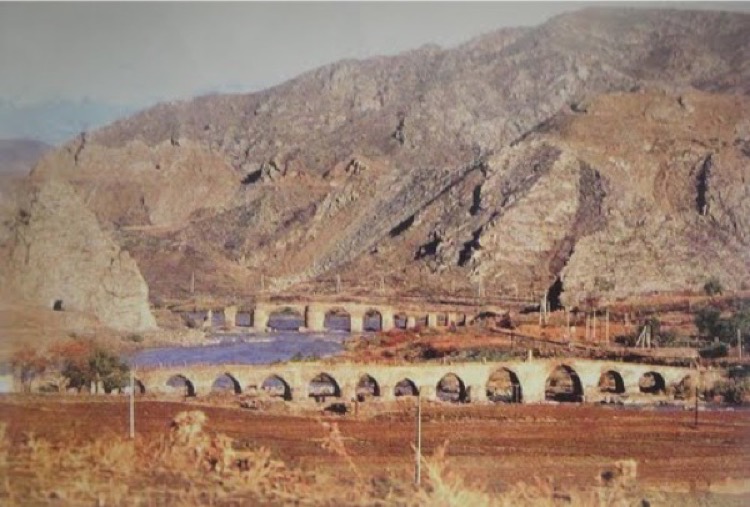The policy of genocide and «ethnic cleansing» that Armenia allegedly carried out in relation to Azerbaijani people was apparently reflected in active operations of Armenian separatists, since 1988, said to be supported by powerful Armenian lobbies in major Western countries, claims official Official reports by the MFA.
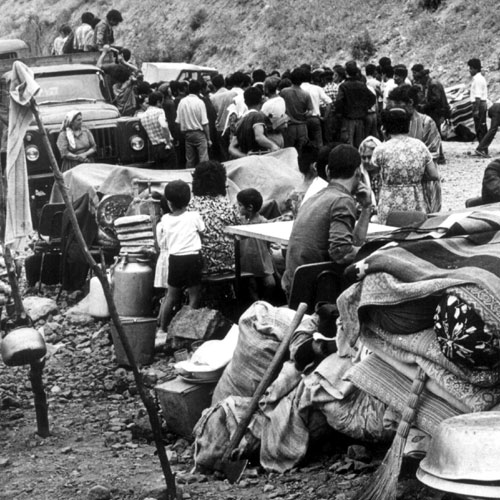
Deportations from Armenia
During the period from 1988 until 1989 about 40,897 families (total: 185,519 people) of Azerbaijanis and Kurds were displaced from their places of permanent residence in Armenia.
At least 218 Azerbaijanis died in the process of which:
- 45 froze to death, trying to escape in the mountains;
- 43 died as a result of beating;
- 34 were killed under torture
s; - 19 died of burns;
- 16 were shot;
- 13 persons died of heart attacks as a result of tortures;
- 6 died in Armenian hospitals;
- 2 drowned;
- 1 person was hanged;
- 2 committed suicide in protest against torture;
- 1 died after he was subjected to electric shock-treatment;
- 1 was beheaded;
- 18 died after being run over by a car;
- 5 persons believed to have been at the hospital, were reported lost and;
- 12 were reported missing.
There is no hope that those who are missing are still alive. Most of those that died were women, children and elderly people.
21 children died during that period, three of them were under 1 years old. Nabiyeva Zohra, a 7-year-old girl, suffered burns. A 3-year-old boy Rahman Mamedov was denied medical care, as a result of which he died. Seven children froze to death; two died after beating, 2 more were shot. A 3-year-old Elman Aliyev died after a heart attack. Four children died after torture, 3 children were run over by a car.
28 women were killed in Armenia. Seven of them were beaten to death, 5 froze, 4 died under torture, 3 died as a result of heart-attack, 2 died under wheels of a car, 1 was beheaded, 1 woman drowned, 1 was burned. Two women died as a result of gunshot wounds that went without medical care, and 1 died at the hospital . Novruzova Banovsha was reported missing. Taking into account the fact that there has been no news from her for nearly 6 years, she is presumed dead.
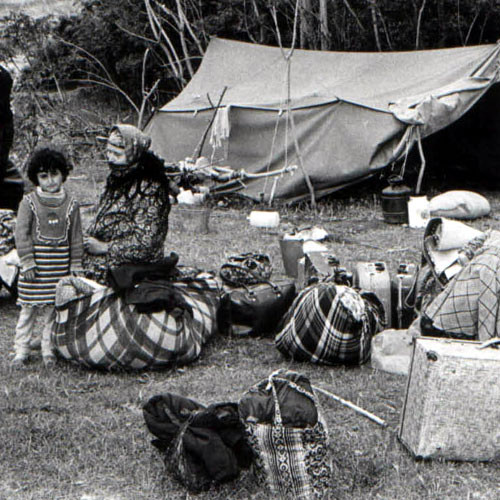
During the deportation from Armenia, 60 elderly persons died. There were 40 men and 20 women among them. Causes of death included torture, bullet wounds, heart attacks, beatings, and frostbite. The following cases are most remarkable:
Aliyeva Ciulsum (76 years old), Isgandarova Khanum (73 years old), Alivev Mehrali (68 years old), Bairamov Garih (67 years old) and Huseynova Leila (63 years old) were burned. Hassan Ellazov, 68 years old, died while in hospital. The crudest acts of brutality were marked in the Ghukark region, 22 persons were killed there and 13 of them died of burns.
Hundreds of centuries old Azerbaijani monuments on the territory of Armenia, where Azerbaijanis had lived in 171 villages across 89 populated areas were either destroyed or Armenised.
Azerbaijan received approximately 50 thousand Meskhetian Turks, refugees from Central Asia. The total amount of damages caused to people, who left their homes in Armenia and Central Asia, is thought to be 255 billion roubles.
In order to remove from history the evidence of Azerbaijanians’ residence in Armenia, about 94 villages were renamed on Armenian territory by a Supreme Soviet Decree of the Republic of Armenia, dated April 9, 1991. Sovereignty and territorial integrity of Azerbaijan republic became the next target of Armenian officials after committing of ethnic cleansing policy against Azerbaijani civilians living on this territory.
Deportations from the occupied territories of Azerbaijan
Following Armenian military action about 20 percent of Azerbaijan’s territory was annexed by the regular Armenian military units and those of Mountainous Karabakh Armenians and foreign mercenaries. More than 700 population centers were badly affected, and only 170 of them were situated in Mountainous Karabakh.
The total number of refugees and displaced persons is over 1 million people (about 200,000 are Azerbaijanis, exiled from Armenia; 50,000 are Meskhet Turks originally from Central Asia). The number of those who left their places of residence as a result of the capture of part of the territory of Azerbaijan is about 800,000 people.
Considerable areas of cultivated land have become unfit for agricultural purposes. More than 4,000 industrial objects, commercial enterprises, and public eateries, about 80,000 places of residence, more than 2,000 objects of social and cultural purpose, including 541 secondary schools, 230 pre-school and 250 medical institutions have been destroyed. The total number of women, men and children killed has reached 16,000 people the number of wounded is over 30,000 people, more than 50,000 people have been disabled, the number of those taken hostage and missing is 4,000.
Among those who were taken hostage were 320 women, 73 of them were old aged (older than 61 years old) and 71 were children. They were kept in different places: many were held in custody in Khankendi, 1 was held in the Ministry of National Security of Armenia, and others were held in private houses. The price for one hostage ranged from around 3 to 15 million roubles. The price for corpses, reached 1 million roubles and in some cases more. One of the most monstrous crimes against Azerbaijani people is the tragedy in Khojaly, a town that was seized by some Armenian troops in February 1992. On February 25 and 26, the Armenian Army, supported by the 336th guards regiment of the Russian Federation, destroyed the Azerbaijani town of Khojaly in Karabakh. Old men, women and children were shot at point blank range, others had their nails pulled, their eyes put out, or their ears cut off. Their only crime was being Azerbaijani. Thousands of people of Khojaly were killed or taken hostage.
Khojaly – Azerbaijan settlement, occupying a strategically location in roads Aghdam-Shusha, Khankendi (Stepanakert)-Askeran. Population of the town: more than 7,000 according to growth of population it became as town. Here found shelter refugees from Uzbekistan-Meskhetian Turks and Azerbaijani refugees from Armenia.
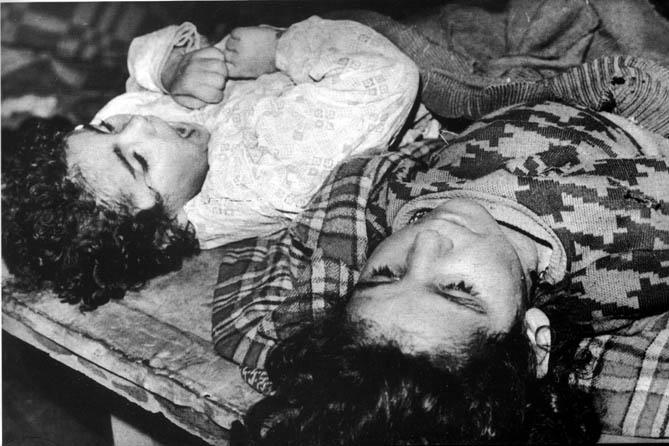
The number of inhabitants of Khojaly, killed or frozen to death is about 1,000 people. Among the killed were children from 2 to 15 years old, women and old men. The position of the corpses demonstrated the fact that people were killed without compassion.
Some were killed one at a time, after being led away, and some – in family groups, all at once. Several corpses showed signs of several wounds, one of which was in the head. It suggests that the wounded were finished off. A number of children killed were found with cut-off ears; the skin from the left side of the face of one old woman had been removed , and men were scalped. According to the testimony of one inhabitant of Khojaly, Sarya Talibova, about 4 Meskhetian Turks – refugees from the Central Asia – and 3 Azerbaijanis were beheaded, their children were tortured and killed. The eyes of 2 Azerbaijanis in the National Army’s uniform were removed using a screwdriver. According to the inhabitants of Khojaly who returned from captivity, they were regularly subjected to torture and beatings, and a number of woman and minors reported being raped.
A number of newspapers and magazines, both Russian and western, published stories about crimes committed between the 1st and the 16th March 1992. Among them are: «The Sunday Times», «The Times», «The Guardian», «Financial Times», «Le Monde», «Le Croix», «Valeurs Actuels», «Corriera della Serra», «Time», «Newsweek», «Izvestiya», «Pravda», «Nezavisimuva gazeta», etc.
Torture and prisoner abuse
On 31 March 1993, when Armenian troops were taking the city of Kelbajar, 11 people, trying to break away from town, were captured and taken hostages. Among them were 7 women, 4 of them wounded. Karimova Samaya, who was born in 1967, committed suicide. She was survived by her 2-year-old daughter, who was bought back for 1,5 million roubles. The child had suffered a head injury during her 4 months spent in prison, and unfortunately lost her eyesight. As for the others, there’s no news about them. According to our information, they are kept in the city of Khankendi. On July 2 1993, the family of Nuriyev, inhabitants of Fizuli, (19 persons in total ), was taken hostage. Among them are: 8 women, 2 of them elderly and 7 children.
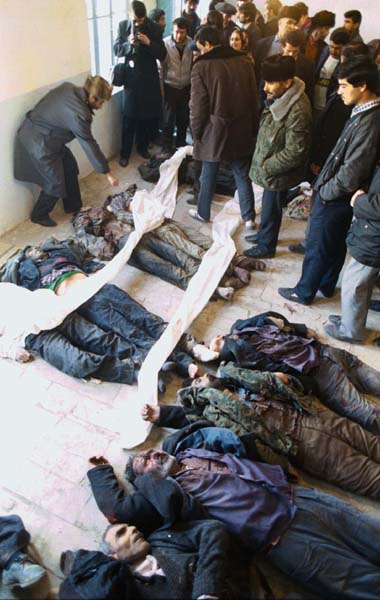
The International Red Cross Committee discovered 47 people, kept in Khankendi. Among them were: 8 women, 7 eldery people and 10 children, including a 10-month-old child Ilyasov Babek, later helped out of captivity with the help of IRCC. According to medical experts, the child wasn’t treated in captivity after a shell burst shrapnel caused an eye wound, and as a result – it’s impossible now to preserve the child’s eyesight.
At the time of the seizure of Aghdam by Armenian troops, a passenger-car carrying 6 people, including the family of Aliyev, trying to get away from the town, was fired on. Among them were 2 women; one of them elderly, an old man and 2 children – aged 2 and 3. The old man and one of the children were killed while they were under the fire. The rest of them were injured to varying degrees. Aliyev Shovghi, the 3-year-old boy, suffered shoulder trauma. After medical attention from Armenian doctors in Khankendi the boy’s shoulder was extracted. Later on, with the efforts of IRCC, his wounded mother and grandmother were returned to their land. According to the results of medical investigation in Baku, doctors said that there was no necessity in extracting his bone and his wound didn’t need such medical actions. According to the opinion of specialists, such gunshot wounds do not usually require extraction of large fragments that are bones of growth zone.
According to some of the world press, Armenia is one of the principal suppliers of human organs for transplantation. This suggests that this child may have become a victim of a criminal business. It’s wrong to accept that this kind of business is one of the principal reasons for taking hostages en masse from occupied Azerbaijanian lands. Numerous facts point to the use of the Azerbaijani captives. According to the brief extract from the case history of Mamedov Mayil, born in October 4, 1971, he was taken by Armenian combatants into captivity in the district of Khankendi and imprisoned, where he was beaten with a gun and a hammer, which resulted in fractures of his left foot bones, left forearm bones and shoulder bones. On October 7, 1992 his chest was burnt by a scorching metal cross. In February, 1993 he was intravenously injected with an unidentified fluid, after which he showed signs of an allergic reaction.
Mamedov Mayil was set free on May 9, 1993 in exchange for an Armenian captive combatant.
According to medical conclusion, Mamedov Abdulazim, 27-year-old, was wounded in the left leg and was taken into Armenian combatant’s captivity. He had suffered a gunshot wound puncture of his left shank tissues and numerous shrapnel injures. According to Mamedov’s words, after an hour long interrogation, he and 8 soldiers of National Army, taken in captivity with him, were beaten with a rubber cudgel on the head, back, hands and then they injected in the neck with some kind of medicine, and afterwards was imprisoned.
While imprisoned he was dragged out on the yard daily and was beaten with the soldier boots’ heels on the head and with rubber cudgels.
Furthermore he was drew the bloody cross on his forehead.In temperatures below zero he was doused with cold water in his cell, on New Year day. He was also hounded by watchdogs leaving traces of scratches, abrasions and bites. They almost didn’t give him any food and injected him with drugs daily, and on occasion he fainted.
According to Mamedov’s words, before captivity his weight was 79 kilos, and after his release – 55 kilos. The majority of captives are exhausted physically.
According to the conclusions of forensic medical experts, the following injures were found on the corpse of Atakishiyev F. R.:
a) pressed fracture of the coronal bone, internal fracture of both the forearm and shank bones, fractures of nose bones, traumatic extraction of the incisive of the both jaws, 61 internal bruises of the head, trunk and extremities;
b) stab punctured stomach wound with the internal organs’ injures, 8 dotted wounds (i.e. traces of injections) of the backside of the neck and left hand injures;
c) 2 punctured gunshot wounds of thigh.
The injures indicated in group (a) appear to have been made with blunt tools. The wounds of hand and forearm might have appeared because of dogs’ bites.
The injures indicated in group (b), appear to have been made with prickly tools and those in group (c) with the firearms.
Deliberate targeting of journalists
In the war that took place with Azerbaijan, 9 representatives of mass media were killed:
- Osman Mirzayev, Press Secretary of President of the Azerbaijani Republic
- Ali Mustafayev – TV journalist
- Fakhraddin Shahbazov – TV cameraman
- Arif Huseyn-zadeh – the cameraman’s assistant, who died in an air catastrophe of Armenian terrorists’ rocket;
including five journalists targeted by Armenian snipers:
- Chingiz Mustafayev, TV cameraman (national hero, posthumously) (Azerbaijan)
- Salatin Askerova, the reporter of a newspaper «Molodezh Azerbaijana» (Azerbaijan)
- Leonid Lazarevitch, the special correspondent of «Mayak» radio station (Russia)
- Valery Dementyev, the editor of a newspaper «Milostivye gosudari» (Russia)
- and Kazimaga Karimov, a journalist (Azerbaijan)
Source: Official reports of the MFA on the Karabakh conflict.





